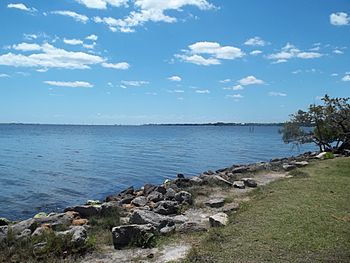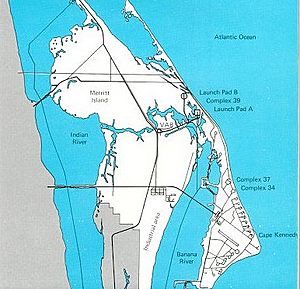Indian River (Florida) facts for kids
The Indian River is a long, narrow body of water in Florida. It's about 121 miles (195 km) long. This special waterway is a type of brackish lagoon. This means its water is a mix of fresh water from rivers and salt water from the ocean. The Indian River is a big part of the larger Indian River Lagoon system. It's also connected to the Atlantic Intracoastal Waterway, which is like a highway for boats along the coast.
Quick facts for kids Indian River |
|
|---|---|

Indian River at Melbourne
|
|

NASA map showing Indian River on left
|
|
| Country | United States |
| State | Florida |
| Physical characteristics | |
| Main source | Ponce de Leon inlet 0 ft (0 m) |
| River mouth | St. Lucie Inlet 0 ft (0 m) |
| Length | 121 mi (195 km) |
What is the Indian River?
The Indian River was first called Rio de Ais. This name came from the Ais Indian tribe, who lived along Florida's east coast a long time ago. Later, it was given its current name, the Indian River.
Where Does the Indian River Flow?
The Indian River starts in the north near New Smyrna Beach. It flows south through Volusia County. It passes by the Haulover Canal and runs along the west side of Merritt Island. The Banana River also flows into the Indian River near Merritt Island. The Indian River continues its journey south until it reaches the St. Lucie Inlet.
Sometimes, especially at certain times of the year, bridges can slow down the water flow. This can cause a type of red algae, called gracilaria, to build up. When this happens, it can sometimes create a smell like rotten eggs. This smell comes from a natural gas called hydrogen sulfide.
Rivers and Bays that Join the Indian River
Many smaller rivers and canals flow into the Indian River. These are called tributaries. Some of these include:
- Merritt Island Barge Canal (which was made by people)
- C-54 Canal (also made by people)
- Crane Creek
- Eau Gallie River
- Horse Creek
- Mullet Creek
- St. Sebastian River
- St. Lucie River
- Sykes Creek
- Turkey Creek
A part of the Indian River that reaches inland, like a large bay, is called an estuary. One example is Palm Bay.

